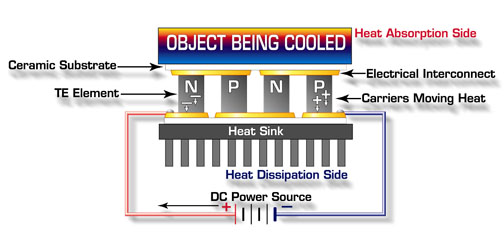A Guide to Thermoelectrics
A thermoelectric (TE) module, also called a thermoelectric cooler or Peltier cooler, is a semiconductor-based electronic component that functions as a small heat pump, moving heat from one side of the device to the other. Thermoelectric modules are also sometimes used to generate electricity by using a temperature differential between the two sides of the module.
Thermoelectric Technical Reference Guide
A comprehensive technical explanation of thermoelectrics
View technologyThermoelectric Cooling Versus Traditional Refrigerant-based Systems
Provides a guide to the advantages of using thermoelectric cooling in select applications
View technologyThermoelectric Module Basics
By applying a low voltage DC power to a TE module, heat will be moved through the module from one side to the other. One module face, therefore, will be cooled while the opposite face is simultaneously heated. It is important to note that this phenomenon may be reversed whereby a change in the polarity (plus and minus) of the applied DC voltage will cause heat to be moved in the opposite direction. Consequently, a thermoelectric module may be used for both heating and cooling thereby making it highly suitable for precise temperature control applications. A thermoelectric module can also be used for power generation. In this mode, a temperature differential applied across the module will generate a current.
A practical thermoelectric module generally consists of two or more elements of n and p-type doped semiconductor material that are connected electrically in series and thermally in parallel. These thermoelectric elements and their electrical interconnects typically are mounted between two ceramic substrates. The substrates hold the overall structure together mechanically and electrically insulate the individual elements from one another and from external mounting surfaces. Most thermoelectric modules range in size from approximately 2.5-50 mm (0.1 to 2.0 inches) square and 2.5-5mm (0.1 to 0.2 inches) in height. A variety of different shapes, substrate materials, metallization patterns and mounting options are available.

The schematic diagram above shows a typical thermoelectric module assembly. Both N-type and P-type Bismuth Telluride thermoelectric materials are used in a thermoelectric cooler. This arrangement causes heat to move through the cooler in one direction only while the electrical current moves back and forth alternately between the top and bottom substrates through each N and P element. N-type material is doped so that it will have an excess of electrons (more electrons than needed to complete a perfect molecular lattice structure) and P-type material is doped so that it will have a deficiency of electrons (fewer electrons than are necessary to complete a perfect lattice structure). The extra electrons in the N material and the “holes” resulting from the deficiency of electrons in the P material are the carriers which move the heat energy through the thermoelectric material. Most thermoelectric cooling modules are fabricated with an equal number of N-type and P-type elements where one N and P element pair form a thermoelectric “couple.” For example, the module illustrated above has two pairs of N and P elements and is termed a “two-couple module”.
Cooling capacity (heat actively pumped through the thermoelectric module) is proportional to the magnitude of the applied DC electric current and the thermal conditions on each side of the module. By varying the input current from zero to maximum, it is possible to regulate the heat flow and control the surface temperature.
Thermoelectric modules offer many advantages including:
- No moving parts
- Small and lightweight
- Maintenance-free
- Acoustically silent and electrically “quiet”
- Heating and cooling with the same module (including temperature cycling)
- Wide operating temperature range
- Highly precise temperature control (to within 0.1°C)
- Operation in any orientation, zero gravity and high G- levels
- Environmentally friendly
- Sub-ambient cooling
- Cooling to very low temperatures (-80°C)
Do You Need More Information?
Contact your local China Advanced Ceramic thermal solutions representative.